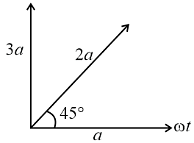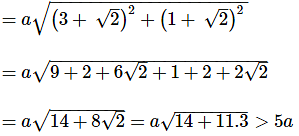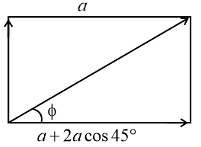JEE Exam > JEE Questions > Three simple harmonic motions in the same di...
Start Learning for Free
Three simple harmonic motions in the same direction having the amplitudes a, 2a and 3a respectively are superposed. If each differ in phase from the next by 45o , then find out the correct options (Consider that all have the same frequency)
- a)The resultant amplitude is 5a.
- b)The resultant amplitude is greater than 5a.
- c)The phase of the resultant motion relative to the motion with amplitude a is tan−1(1 + 2√2)
- d)The phase of the resultant motion relative to the motion with amplitude a is tan−1(2√2 − 1)
Correct answer is option 'B,D'. Can you explain this answer?
| FREE This question is part of | Download PDF Attempt this Test |
Most Upvoted Answer
Three simple harmonic motions in the same direction having the amplit...

y1 = asinωt
y2 = 2asin(ωt + 45o)
y3 = 3asin(ωt + 90o)
Resultant = 




Free Test
FREE
| Start Free Test |
Community Answer
Three simple harmonic motions in the same direction having the amplit...
Given:
Three simple harmonic motions in the same direction
Amplitudes: a, 2a, 3a
Phase difference between each motion: 45°
Frequency: Same for all motions
To find:
Options:
a) The resultant amplitude is 5a.
b) The resultant amplitude is greater than 5a.
c) The phase of the resultant motion relative to the motion with amplitude a is tan−1(1 + 2√2)
d) The phase of the resultant motion relative to the motion with amplitude a is tan−1(2√2 − 1)
Solution:
Step 1: Find the equation of each simple harmonic motion:
The equation of a simple harmonic motion is given by:
x = A * sin(ωt + φ)
where,
x = displacement at time t
A = amplitude of the motion
ω = angular frequency (2πf)
f = frequency of the motion
φ = phase constant
For the three motions:
Motion 1: x1 = a * sin(ωt + φ1)
Motion 2: x2 = 2a * sin(ωt + φ2)
Motion 3: x3 = 3a * sin(ωt + φ3)
Step 2: Find the resultant motion by superposing the three motions:
The resultant motion can be obtained by adding the individual motions together:
Resultant motion: x = x1 + x2 + x3
Step 3: Express the individual motions in terms of a common phase:
Given that the phase difference between each motion is 45°, we can express the motions in terms of a common phase, say φ1.
Using trigonometric identities:
sin(φ2) = sin(φ1 + 45°) = sin(φ1)cos(45°) + cos(φ1)sin(45°) = (1/√2)(sin(φ1) + cos(φ1))
sin(φ3) = sin(φ1 + 90°) = sin(φ1)cos(90°) + cos(φ1)sin(90°) = cos(φ1)
Therefore,
Motion 1: x1 = a * sin(ωt + φ1)
Motion 2: x2 = 2a * (1/√2)(sin(ωt + φ1) + cos(ωt + φ1))
Motion 3: x3 = 3a * cos(ωt + φ1)
Step 4: Find the resultant motion by adding the individual motions:
x = x1 + x2 + x3
= a * sin(ωt + φ1) + 2a * (1/√2)(sin(ωt + φ1) + cos(ωt + φ1)) + 3a * cos(ωt + φ1)
= a * sin(ωt + φ1) + a * (1/√2)(sin(ωt + φ1) + cos(ωt + φ1)) + 3a * cos(ωt + φ1)
= a * [sin(ωt + φ1) + (1/
Three simple harmonic motions in the same direction
Amplitudes: a, 2a, 3a
Phase difference between each motion: 45°
Frequency: Same for all motions
To find:
Options:
a) The resultant amplitude is 5a.
b) The resultant amplitude is greater than 5a.
c) The phase of the resultant motion relative to the motion with amplitude a is tan−1(1 + 2√2)
d) The phase of the resultant motion relative to the motion with amplitude a is tan−1(2√2 − 1)
Solution:
Step 1: Find the equation of each simple harmonic motion:
The equation of a simple harmonic motion is given by:
x = A * sin(ωt + φ)
where,
x = displacement at time t
A = amplitude of the motion
ω = angular frequency (2πf)
f = frequency of the motion
φ = phase constant
For the three motions:
Motion 1: x1 = a * sin(ωt + φ1)
Motion 2: x2 = 2a * sin(ωt + φ2)
Motion 3: x3 = 3a * sin(ωt + φ3)
Step 2: Find the resultant motion by superposing the three motions:
The resultant motion can be obtained by adding the individual motions together:
Resultant motion: x = x1 + x2 + x3
Step 3: Express the individual motions in terms of a common phase:
Given that the phase difference between each motion is 45°, we can express the motions in terms of a common phase, say φ1.
Using trigonometric identities:
sin(φ2) = sin(φ1 + 45°) = sin(φ1)cos(45°) + cos(φ1)sin(45°) = (1/√2)(sin(φ1) + cos(φ1))
sin(φ3) = sin(φ1 + 90°) = sin(φ1)cos(90°) + cos(φ1)sin(90°) = cos(φ1)
Therefore,
Motion 1: x1 = a * sin(ωt + φ1)
Motion 2: x2 = 2a * (1/√2)(sin(ωt + φ1) + cos(ωt + φ1))
Motion 3: x3 = 3a * cos(ωt + φ1)
Step 4: Find the resultant motion by adding the individual motions:
x = x1 + x2 + x3
= a * sin(ωt + φ1) + 2a * (1/√2)(sin(ωt + φ1) + cos(ωt + φ1)) + 3a * cos(ωt + φ1)
= a * sin(ωt + φ1) + a * (1/√2)(sin(ωt + φ1) + cos(ωt + φ1)) + 3a * cos(ωt + φ1)
= a * [sin(ωt + φ1) + (1/
Attention JEE Students!
To make sure you are not studying endlessly, EduRev has designed JEE study material, with Structured Courses, Videos, & Test Series. Plus get personalized analysis, doubt solving and improvement plans to achieve a great score in JEE.

|
Explore Courses for JEE exam
|

|
Similar JEE Doubts
Three simple harmonic motions in the same direction having the amplitudes a, 2a and 3a respectively are superposed. If each differ in phase from the next by 45o , then find out the correct options (Consider that all have the same frequency)a)The resultant amplitude is 5a.b)The resultant amplitude is greater than 5a.c)The phase of the resultant motion relative to the motion with amplitude a is tan−1(1 + 2√2)d)The phase of the resultant motion relative to the motion with amplitude a is tan−1(2√2 − 1)Correct answer is option 'B,D'. Can you explain this answer?
Question Description
Three simple harmonic motions in the same direction having the amplitudes a, 2a and 3a respectively are superposed. If each differ in phase from the next by 45o , then find out the correct options (Consider that all have the same frequency)a)The resultant amplitude is 5a.b)The resultant amplitude is greater than 5a.c)The phase of the resultant motion relative to the motion with amplitude a is tan−1(1 + 2√2)d)The phase of the resultant motion relative to the motion with amplitude a is tan−1(2√2 − 1)Correct answer is option 'B,D'. Can you explain this answer? for JEE 2024 is part of JEE preparation. The Question and answers have been prepared according to the JEE exam syllabus. Information about Three simple harmonic motions in the same direction having the amplitudes a, 2a and 3a respectively are superposed. If each differ in phase from the next by 45o , then find out the correct options (Consider that all have the same frequency)a)The resultant amplitude is 5a.b)The resultant amplitude is greater than 5a.c)The phase of the resultant motion relative to the motion with amplitude a is tan−1(1 + 2√2)d)The phase of the resultant motion relative to the motion with amplitude a is tan−1(2√2 − 1)Correct answer is option 'B,D'. Can you explain this answer? covers all topics & solutions for JEE 2024 Exam. Find important definitions, questions, meanings, examples, exercises and tests below for Three simple harmonic motions in the same direction having the amplitudes a, 2a and 3a respectively are superposed. If each differ in phase from the next by 45o , then find out the correct options (Consider that all have the same frequency)a)The resultant amplitude is 5a.b)The resultant amplitude is greater than 5a.c)The phase of the resultant motion relative to the motion with amplitude a is tan−1(1 + 2√2)d)The phase of the resultant motion relative to the motion with amplitude a is tan−1(2√2 − 1)Correct answer is option 'B,D'. Can you explain this answer?.
Three simple harmonic motions in the same direction having the amplitudes a, 2a and 3a respectively are superposed. If each differ in phase from the next by 45o , then find out the correct options (Consider that all have the same frequency)a)The resultant amplitude is 5a.b)The resultant amplitude is greater than 5a.c)The phase of the resultant motion relative to the motion with amplitude a is tan−1(1 + 2√2)d)The phase of the resultant motion relative to the motion with amplitude a is tan−1(2√2 − 1)Correct answer is option 'B,D'. Can you explain this answer? for JEE 2024 is part of JEE preparation. The Question and answers have been prepared according to the JEE exam syllabus. Information about Three simple harmonic motions in the same direction having the amplitudes a, 2a and 3a respectively are superposed. If each differ in phase from the next by 45o , then find out the correct options (Consider that all have the same frequency)a)The resultant amplitude is 5a.b)The resultant amplitude is greater than 5a.c)The phase of the resultant motion relative to the motion with amplitude a is tan−1(1 + 2√2)d)The phase of the resultant motion relative to the motion with amplitude a is tan−1(2√2 − 1)Correct answer is option 'B,D'. Can you explain this answer? covers all topics & solutions for JEE 2024 Exam. Find important definitions, questions, meanings, examples, exercises and tests below for Three simple harmonic motions in the same direction having the amplitudes a, 2a and 3a respectively are superposed. If each differ in phase from the next by 45o , then find out the correct options (Consider that all have the same frequency)a)The resultant amplitude is 5a.b)The resultant amplitude is greater than 5a.c)The phase of the resultant motion relative to the motion with amplitude a is tan−1(1 + 2√2)d)The phase of the resultant motion relative to the motion with amplitude a is tan−1(2√2 − 1)Correct answer is option 'B,D'. Can you explain this answer?.
Solutions for Three simple harmonic motions in the same direction having the amplitudes a, 2a and 3a respectively are superposed. If each differ in phase from the next by 45o , then find out the correct options (Consider that all have the same frequency)a)The resultant amplitude is 5a.b)The resultant amplitude is greater than 5a.c)The phase of the resultant motion relative to the motion with amplitude a is tan−1(1 + 2√2)d)The phase of the resultant motion relative to the motion with amplitude a is tan−1(2√2 − 1)Correct answer is option 'B,D'. Can you explain this answer? in English & in Hindi are available as part of our courses for JEE.
Download more important topics, notes, lectures and mock test series for JEE Exam by signing up for free.
Here you can find the meaning of Three simple harmonic motions in the same direction having the amplitudes a, 2a and 3a respectively are superposed. If each differ in phase from the next by 45o , then find out the correct options (Consider that all have the same frequency)a)The resultant amplitude is 5a.b)The resultant amplitude is greater than 5a.c)The phase of the resultant motion relative to the motion with amplitude a is tan−1(1 + 2√2)d)The phase of the resultant motion relative to the motion with amplitude a is tan−1(2√2 − 1)Correct answer is option 'B,D'. Can you explain this answer? defined & explained in the simplest way possible. Besides giving the explanation of
Three simple harmonic motions in the same direction having the amplitudes a, 2a and 3a respectively are superposed. If each differ in phase from the next by 45o , then find out the correct options (Consider that all have the same frequency)a)The resultant amplitude is 5a.b)The resultant amplitude is greater than 5a.c)The phase of the resultant motion relative to the motion with amplitude a is tan−1(1 + 2√2)d)The phase of the resultant motion relative to the motion with amplitude a is tan−1(2√2 − 1)Correct answer is option 'B,D'. Can you explain this answer?, a detailed solution for Three simple harmonic motions in the same direction having the amplitudes a, 2a and 3a respectively are superposed. If each differ in phase from the next by 45o , then find out the correct options (Consider that all have the same frequency)a)The resultant amplitude is 5a.b)The resultant amplitude is greater than 5a.c)The phase of the resultant motion relative to the motion with amplitude a is tan−1(1 + 2√2)d)The phase of the resultant motion relative to the motion with amplitude a is tan−1(2√2 − 1)Correct answer is option 'B,D'. Can you explain this answer? has been provided alongside types of Three simple harmonic motions in the same direction having the amplitudes a, 2a and 3a respectively are superposed. If each differ in phase from the next by 45o , then find out the correct options (Consider that all have the same frequency)a)The resultant amplitude is 5a.b)The resultant amplitude is greater than 5a.c)The phase of the resultant motion relative to the motion with amplitude a is tan−1(1 + 2√2)d)The phase of the resultant motion relative to the motion with amplitude a is tan−1(2√2 − 1)Correct answer is option 'B,D'. Can you explain this answer? theory, EduRev gives you an
ample number of questions to practice Three simple harmonic motions in the same direction having the amplitudes a, 2a and 3a respectively are superposed. If each differ in phase from the next by 45o , then find out the correct options (Consider that all have the same frequency)a)The resultant amplitude is 5a.b)The resultant amplitude is greater than 5a.c)The phase of the resultant motion relative to the motion with amplitude a is tan−1(1 + 2√2)d)The phase of the resultant motion relative to the motion with amplitude a is tan−1(2√2 − 1)Correct answer is option 'B,D'. Can you explain this answer? tests, examples and also practice JEE tests.

|
Explore Courses for JEE exam
|

|
Suggested Free Tests
Signup for Free!
Signup to see your scores go up within 7 days! Learn & Practice with 1000+ FREE Notes, Videos & Tests.
























